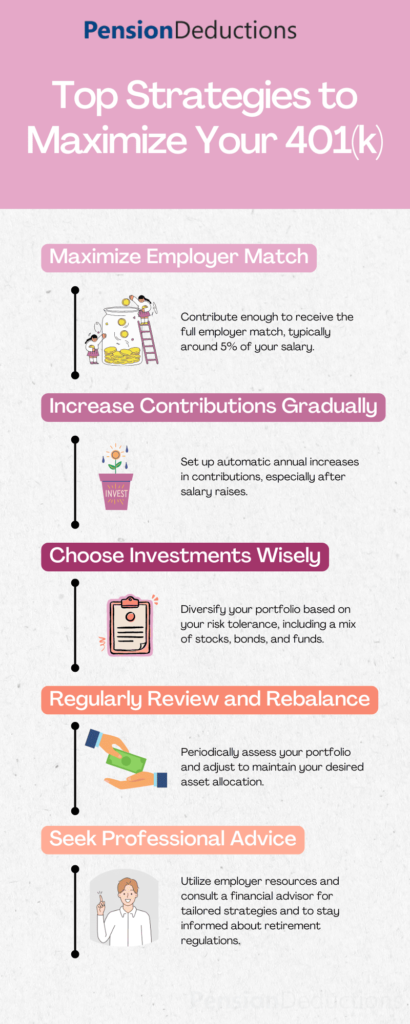Best Strategies to Maximize Your 401k for a Secure Retirement
Understanding 401k Plans
Why Use a 401k?
Tax Benefits
Contributions are made pre-tax, reducing your taxable income for the year. This can lead to significant tax savings, especially if you’re in a higher tax bracket.
Employer Matching
Many employers offer matching contributions, which is essentially free money. Not taking full advantage of this benefit is like leaving money on the table.
Investment Options
401k plans typically offer a range of investment options, including mutual funds, stocks, and bonds, allowing for portfolio diversification.
Strategies to Maximize Your 401k

Contribute Enough to Get the Full Employer Match
One of the simplest strategies to maximize your 401k is to contribute enough to receive the full employer match. For example, if your employer matches up to 5% of your salary, ensure that you are contributing at least 5%. Not doing so means you’re missing out on free money that can significantly boost your retirement savings.
Increase Your Contributions Gradually
If you’re not able to max out your contributions right away, consider increasing your contribution percentage gradually. Many plans allow you to set an automatic increase each year. This can be done after you receive a raise or when your budget allows for more savings. This technique, known as “auto-escalation,” helps you build your savings without feeling the pinch. It’s one of the effective strategies to maximize your 401k.
Take Advantage of Catch-Up Contributions
If you’re aged 50 or older, you can make catch-up contributions to your 401k. For 2024, the catch-up contribution limit is $7,500, allowing you to save more as you approach retirement. Utilizing this option can be one of the most effective strategies to maximize your 401k as it helps boost your savings significantly in your final working years.
Choose Investments Wisely
Choosing the right investments is crucial for your strategies in maximizing your 401k. Take the time to review the investment options available in your plan and consider factors such as:
Risk Tolerance: Determine how much risk you’re comfortable taking. Younger investors can typically afford to take on more risk, while those closer to retirement may want to be more conservative.
Diversification: Ensure your portfolio is well-diversified across various asset classes, such as stocks, bonds, and mutual funds. This reduces risk and can enhance returns.
Cost: Pay attention to the fees associated with different investment options. High fees can erode your returns over time, so look for low-cost index funds or ETFs when possible.
Regularly Review and Rebalance Your Portfolio
It’s important to regularly review your investment portfolio and rebalance it as needed. Over time, certain investments may outperform others, leading to an unintentional change in your asset allocation. Rebalancing involves selling some of the over-performing assets and buying underperforming ones to maintain your desired allocation. This is an essential step in the strategies to maximize your 401k.
Keep an Eye on Fees
As mentioned earlier, fees can eat away at your investment returns. Pay close attention to the expense ratios of the funds you’re invested in. Opt for low-cost index funds or ETFs to minimize fees. It’s essential to understand both the management fees and any additional administrative fees associated with your 401k plan, as these can impact your overall investment growth.
Be Mindful of Withdrawals
When you leave an employer, you typically have several options regarding your 401k. You can cash it out, roll it over into an IRA, or leave it with your former employer. However, cashing out can incur hefty taxes and penalties, reducing your retirement savings. Instead, consider rolling over your 401k into an IRA or your new employer’s plan, which can help maintain the tax-deferred status of your savings.
Educate Yourself
Financial literacy is key to effectively managing your retirement savings. Take the time to educate yourself about 401k plans, investment options, and retirement planning. Many employers offer resources or workshops to help employees understand their benefits better. Additionally, consider reading books, attending seminars, or following reputable financial blogs to enhance your knowledge. Knowledge is power when implementing strategies to maximize your 401k.
Plan for Retirement Income
When planning for retirement, think about how you will generate income from your 401k savings. Consider strategies such as systematic withdrawals, annuities, or other income-generating investments. Understanding your income needs during retirement will help you determine how much you should withdraw annually from your 401k to maintain your lifestyle. Planning for income is one of the important strategies to maximize your 401k.
Seek Professional Financial Advice
If navigating your 401k feels overwhelming, consider seeking professional financial advice. A financial advisor can help you develop a personalized strategy based on your specific goals, risk tolerance, and timeline. They can also assist you in making informed decisions regarding investments, withdrawals, and tax implications, further enhancing your strategies to maximize your 401k.
The Importance of Staying Informed
Recent Trends in 401k Management
The Role of Technology in Retirement Planning
Conclusion
Ultimately, the more proactive you are in managing your 401k, the better positioned you will be for a successful retirement. So, take the time to evaluate your current savings strategy and consider how you can implement these strategies to maximize your 401k today. Whether you’re just starting out in your career or are nearing retirement, adopting these strategies can make a significant difference in your financial future.
SHARE THIS POST
Discover the key differences between a Defined Benefit Plan vs 401k, and find the best pension plan for small business owners.
Explore the latest Retirement Trends in 2025, including 401(k) updates, automatic portability, and inflation-resistant strategies, to secure your future.
Discover the 3 retirement rule changes in 2025, including contribution limits, RMD updates, and automatic portability. Plan smarter today!
Year-end financial planning in the USA helps optimize retirement savings, reduce taxes, and secure your future with proactive strategies.


